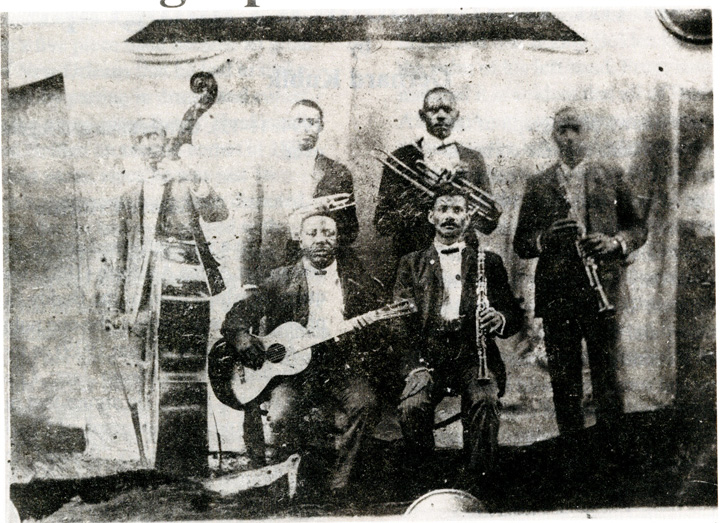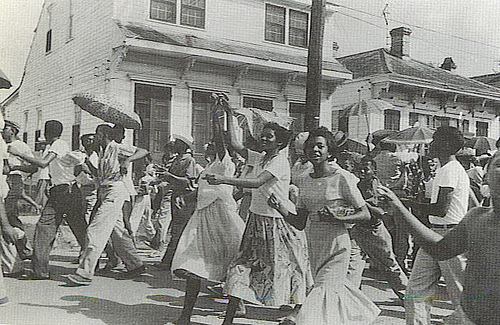"Second line bands, the bands that march in the streets, initially was done for funerals," Allen Toussaint said. "To march real slow on the way to the funeral and cut up on the way back. That’s how you lay the dead away—with a band. You take ‘em on out and you boogie back."
Toussaint, the pianist, producer, and New Orleans music legend, gave this summation of the city’s brass band tradition in Always For Pleasure, a 1978 documentary by Les Blank. Toussaint couldn’t remember exactly when it started, as the festive street celebrations of mourners and bands had begun long before he was born.
As anyone who has ever visited the city will know, the tradition is still alive. Brass bands and the "second line"—the revelers, neighbors, and strangers jumping in from the sidewalk to join the parade—accompany not only funerals, but weddings, births, holidays, and impromptu parties of all sorts.
The musicians, of course, keep the music alive not just on sidewalks and streets, but in the city’s myriad bars, clubs, and venues, on records, and on tours throughout the world.
In honor of Mardi Gras and the tricentennial celebration of the founding of New Orleans, we’re tracing the course of the living tradition from its earliest days through its many eras—as musicians brought and continue to bring new genres and influences into the age-old ensembles.
The Birth of the Funeral Parade
Danny Barker was a third-generation jazz musician born in New Orleans in 1909. His grandfather Isidore Barbarin, a locally famous musician, was born in 1871, just six years after the Civil War and the formal end of slavery. Barker, a guitarist and banjo player who began playing music early in life under the eye of Isidore and other musicians in the Barbarin clan, would go on to play with Cab Calloway, Sidney Bechet, Benny Carter, Jelly Roll Morton, and many more jazz legends.
Barker also became one of New Orleans’ greatest historians and champions of brass bands. His book A Life in Jazz recounts the earliest days of black marching bands, the birth of jazz, and the many permutations the music took between his grandfather’s heyday and 1986, when the book was first published.

With a perhaps apocryphal story, Barker shares what he and others say was the first music-filled procession, which took place at the turn of the 17th century.
Pierre Le Moyne d’Iberville and his younger brother Jean-Baptiste Le Moyne, Sieur de Bienville, (now remembered as Iberville and Bienville) explored the area around the mouth of the Mississippi River, looking for good areas to claim for King Louis XIV. Iberville would found the first permanent French settlement in the Louisiana Territory in 1699, while Bienville established New Orleans in 1718.
"One old writer relates that, with the founding of New Orleans by the brothers Bienville and Iberville, there was a body of soldiers with the explorers and that a trumpet player with the military band died and was buried in the military fashion with music in the funeral procession and at the grave site," Barker writes.
While Barker says that other writers recall celebratory funerals by the city’s black population even during slavery, it wasn’t until emancipation in 1865 and the resulting freedoms afforded to black musicians that brass bands really took off.
By the time Barker was born in 1909, his grandfather Isidore was playing cornet and alto horn with the Onward Brass Band, one of the city’s best organized groups. As a child living with his grandparents, Barker remembered that all the talk around the house was about music—which players could play, which players couldn’t, and which gigs Onward had won or lost to some of its fierce competitors like the Excelsior Brass Band.
Then as now, benevolent societies in the city’s black wards would pool the money of their members in order to throw big funerals for the recently departed. Onward, Excelsior, and countless other professional and family bands would compete for the funeral gigs, just as they’d maneuver to play any other social occasion.
While playing in Onward alongside musicians like Manuel Perez and Joe "King" Oliver, Isidore also worked as a carriage driver for one of the busiest undertakers. The arrangement gave him early intel on when a society’s member was deathly ill or when a funeral was being planned, and he’d angle with the club or the grieving family for Onward to be hired.
"All sorts of espionage was employed when a sick brother was at death’s door," Barker writes.
Barker shares the scene from the funeral after the crowd had let the hearse pass. "In a few minutes the big bass drum strikes three extra-loud booms and the band starts swinging ‘The Saints,’ or ‘Didn’t He Ramble,’ or ‘Bourbon Street Parade,’ and the wild, mad, frantic dancing starts, and the hundreds of all-colored umbrellas are seen bouncing high above heads to the rhythm of the great crowd of second liners," he writes.
The revelers—and especially children with a budding interest in music—were enthralled by the musicians and the scene they seemed to conjure from their horns. Barker recalls how sad it was to be stuck in a classroom and hear a band strike up down the street, and what a joy it was to cut class to join the parade. He writes, "It was the greatest thrill to a kid to get to hold the instrument of a musician whom he idolized."
Passing On the Contentious and Living Tradition
While Isidore Barbarin and his contemporaries were studiously learning the parade songs of their day, a new music was being invented across town—jazz. Though the worlds would soon mix, the brass band tradition was initially separate from the budding jazz scene, as embodied by Buddy Bolden.
Bolden was a loud and brash cornetist who was one of the first to play so freely—reciting a melody from memory and brazenly riffing on it as he pleased—that he came to be regarded as one of the first true jazz players. Bolden’s band, which was popular from around 1895 to 1907, and others like them would play at the many social clubs, street corner bars, and dance halls in the black wards of New Orleans.
As recounted in Jazzmen, a collection of essays on early jazz written in 1939, Bolden played clubs like the Perseverance Hall, The Buzzards, and the Tin Type Hall, where "the music was mean and dirty" and the song lyrics could be confused for today’s strip club anthems.

Isidore, like other trained musicians at the time, looked down on such musicians. Barker writes that he called them "routine" as a slur because they couldn’t read music and therefore had to learn by routine. Of Bolden, Isidore told Barker, "Sure, I heard him. I knew him. He was famous with the ratty people."
These jazz bands also competed with the brass bands for gigs and the rapt attentions of audiences. For the many parades and celebrations thrown by the city’s social clubs and Carnival "krewes," jazz bands would perform on the flatbeds of horse-drawn carriages and, later, automobiles. Their mobile setups, complete with a double bass and a small drum kit, would move slowly down the streets as second liners followed and danced close behind.

But that kind of animosity soon fell out of favor. Even the younger members of Isidore’s Onward Brass Band, like King Oliver and Manuel Perez (who would start leading the band in 1903) were hired by hot jazz groups like Kid Ory and His Creole Jazz Band while playing with Onward. And soon, these artists would become famous across the country for their jazz music.
To younger musicians like Barker, jazz and traditional brass band music were always intertwined, and his generation understood the importance of learning the classics while swinging them. Louis Armstrong, born in 1901, was a slightly older peer of Barker’s that would, of course, go on to be one of the most popular jazz musicians of his time.
In private writings published by New Orleans’ Offbeat magazine, Armstrong said, "Manuel [Perez] and Joe King Oliver played together in the Onward Brass Band, really something to listen to when they played for parades and funerals. They had twelve musicians in their brass band. Eddie Jackson used to really swing the tuba when the band played marches. They sounded like a forty piece brass swing band."
Later on in his career, Armstrong would become a torchbearer for the type of jazz he knew from an early age and complain that the bebop players gaining favor in the ‘40s and ‘50s were playing "weird chords … no melody to remember and no beat to dance to."
Barker, after a move to New York as a young man, an eight-year run with Cab Calloway’s big band, and decades of playing traditional- and swing-era jazz, would even record with bebop legends like Charlie Parker. However, he felt he wasn’t the right fit. He returned to New Orleans in 1965 to live a quieter life, got a job at the then-new New Orleans Jazz Museum, and ended up forming a traditionally minded brass band at a local church.
The New Orleans of the ‘50s and ‘60s, like much of the rest of the country, turned away from jazz and toward R&B, soul, and rock ‘n’ roll. Luminaries of that era, like Toussaint and The Meters, certainly brought parade-style playing to their music. Even Earl Palmer—one of the drummers of Los Angeles’ "Wrecking Crew" that brought bass drum stylings from his native New Orleans to Phil Spector, Sam Cooke, and David Axelrod records—had an unmistakable lilt from his years in the Tremé.
But the street-level tradition was at a lull. The group that Barker formed upon his return to New Orleans—the Fairview Baptist Church Marching Band—is now widely credited with pulling the tradition back from its lowest point. The group was only together from 1970 to 1974, but during that time, Barker took a whole new generation of players under his wing.
The members of that band and the associated circle of players that sprung up around it included Leroy Jones, Branford Marsalis, and Wynton Marsalis—who would become leading lights of a new style of jazz that incorporated the popular music of the day. In the wake of the Fairview Marching Band, former members launched a constellation of brass bands that brought bebop and funk music into the mix.

The Dirty Dozen Brass Band was one such group that found fame across the country with their heavy, funky sound—opening the way for other artists like Trombone Shorty, Glen David Andrews, the Hot 8 Brass Band, and the Rebirth Brass Band to continue to blend new genres like rock, hip-hop, and bounce with the traditional music of Isidore Barbarin, King Oliver, and Danny Barker.
Today, on Fat Tuesday, some three-hundred years since New Orleans’ first brass funeral, second liners have their choice. Both the traditionally minded Treme Brass Band and Rebirth—whose most famous line is "Do watcha wanna / Smoke marijuana"—will be performing, each group preserving and pushing the tradition forward in their own way.
